http://www.osirisnet.net/tombes/nobles/anonyme175/e_anonyme175_01.htm

Thanks to Professor Lise Manniche (University of Copenhagen) for her help
The tiny Theban Tomb TT175 has the distinction of being decorated, but
not inscribed: columns for the texts are present but empty (with one
small exception); so we do not know the owner's name.The dating is based solely on stylistic criteria and is still debated, the middle of the eighteenth dynasty and especially the reign of Thutmose IV (~ 1400-1390 BC), winning the majority of votes.
The chapel is dug in the poor quality limestone of el-Khokha hill (view ARCE); its nearest neighbors are the tombs TT176 (Userhat) and TT177 (Amenemopet) that have already been presented on OsirisNet. Reported in 1913 for the first time by Gardiner and Weigall, the tomb was fully published in 1988 by Lise Manniche in a work that was the basis for this description.
General presentation
|
After crossing the entrance, one enters a small room of 1.60 x 1 m (Manniche), where painters have packed as many scenes as possible which were considered as indispensable by the owner.
The paintings were executed on a thin layer of white plaster, unevenly distributed over a coating of mouna (a mixture of straw and Nile mud) in order to level the surface of the walls. The ceiling was not decorated.
The paintings, overall of average quality, are very damaged, the black colour especially has almost disappeared. All colours, except white and those used in the banquet scene, were mixed with a fixative (?) which, with the passing of time, has given a patina of bronze and caused the erosion of many scenes.
The chapel has not undergone the mutilations of Akhenaten’s zealots, in particular the representation of the sem-priest has not been touched (see on this subject Rekhmire) and the damage that can be found in the owner and his wife’s faces seems natural. Kozloff notes that TT 175 belongs to a group of chapels where painters used a rich colour palette, where details are meticulously rendered, with interrelationships between scenes. For Hartwig, the chapel is comparable to other chapels and characterized by an overall static aspect, centered on a large seated representation of the couple formed by the deceased and his wife, while the secondary characters are arranged in small lively scenes. It brings TT 69 (Menna), TT 139 (Pairy), and TT 181 (Nebamun-Ipuky) to mind among others.
The geographical axis of the tomb is almost north-south, which does not match the symbolic east-west, wanted by the Egyptians and in line with which the artists have realized the decor. We therefore consider that the back wall is as the west and the entrance as the east.
THE EAST WALL
This consists of two narrow areas on either side of the entrance. They are subdivided into three registers, each showing a bearer of offerings facing towards the inside of the chapel.
A- Wall on the right hand side (as one enters)
The silhouettes are reduced to sketches (view lm-rw_03d)
B- Wall on the left hand side (view lm-fw)
|
A man walks by holding two bouquets, one large and one small.
2)- Middle register
The person that appears carries lotus flowers and holds a tray on which are placed two baskets of fruit and a loaf of bread (view lm-fwd01). Before him is the only inscription in the chapel, very faint and fragmentary: "the sedjem-ash... (of) Amun, Huy". This title, which literally means "one who hears the word" is usually met in the community of artisans of the royal tomb of the village of Deir el-Medina and translated "follower". But this title is found in other contexts, such as "the sedjem-ash of Amun".
3)- Lower register
A man is carrying a bowl containing glowing incense.
THE NORTH WALL
A- Register 1 (the lowet)
It is oriented in the opposite direction to the other three which are above it. It represents the grain cycle, from planting to harvest, and therefore the repeated sequence of seasons. Renewed from one year to the other, it symbolizes eternity-neheh, cyclic (one of two eternities conceived of by the ancient Egyptians the other being djet a non-temporal eternity- that of Osiris).
|
Two pairs of oxen are involved in the work. Each one of the pair is coloured, one animal has a red coat and the other a white coat sprinkled with black patches (this is practically the only place in the chapel where this color is retained). They pull a plough over which a farmer is bent. Between the two pairs of cattle is a person sowing; another with a basket in the left hand stands behind the second pair of oxen.
|
Then follows a man, armed with a pitchfork, who sends corn onto a pile lying on the threshing floor. Here again are the oxen who, by their trampling, ensure the threshing. To the right of this scene, the reapers cut the ears (a very damaged scene). Finally, on the far left of the register there are three baskets of red fruit that resembles bundles of leaves (view lm-rw01). Two men approach: one holding two birds by their wings, the second carries elongated vases.
B- Register 2: production of ointments and perfumes
|
The technique of distillation was unknown in ancient Egypt, perfumes were produced by soaking fragrant vegetation in a vegetable oil (almond, date palm desert, moringa ...) or in animal fat. Fragrances come from flowers that are able to be infused in the oil then are squeezed out in a cloth; the flowers can also be directly thrown into heated fat. Gums (myrrh, incense ...) and tree chips can also be soaked.is usually met in the community of artisans of the royal tomb of the village of Deir el-Medina and translatedThe existence of solid perfumes is attested, as shown in view bs-38899 : the white mass in a large cup which is placed on a pedestal consists of scented fat; it is rancid on top, as shown by the yellow colour. That this is the finished product is confirmed by the floral wreath. This image brings up again the question of the nature of ointment cones seen capping some of the guests of a banquet: an actual mass of fragrant fat that melts from body heat (and in that case permeates and soils the wig and clothes ); a metaphor for fragrances in general, or an immaterial principle? (J. Padgham: ‘the Theban cone would be the earthly symbol of the Ba receiving offerings’). A discovery made in 2011 will perhaps have everyone agreeing: the ancient Egyptians, men and women surprisingly, using fat as "gel" for their hair (Newscientist).
1)- The right side of the register
|
|
To the left of the jars, a man sitting on a stool with an adze appears to cut small chips from a log; these chips appear in the basket above.
2)- The left side of the register
This is occupied by a representation of the owner sitting on a chair, holding in his hand a cane showing his rank; before him is a well-stocked table of offerings (drawing lm-01).
C- Register 3 and 4
They are all busy; on the right side, with a banqueting scene, while on the left side, two registers become one, with a seated couple sitting, which represents the centre of the entire chapel’s decoration.
1)- Right (drawing lm-01bis)
|
The scene is replicated among the women. A servant offers a cup to a lady, who refuses it: being tipsy makes you closer to the world of the gods, but being drunk makes you sick ...
Overall, this banquet scene is more rigid and conventional in its execution than the rest of the decor and has certainly been created by a different artist.
2)- Left (drawing lm-02bis)
|
Behind the girl are three musicians, two are nude, the third wearing a transparent dress. They play the harp, a long necked lute or a double flute.
THE SOUTH WALL
This is divided into three registers of substantially equal height (view bs-38881). The top register shows a group of offering bearers, the middle, funerary scenes, and the lower the pilgrimage to Abydos.
A- Upper register
|
On the far left (not visible in the photos) stands a woman who has been the subject of an attempted excision, preceded by a man carrying baskets.
We also see a porter who holds a yoke on the shoulders, from which are suspended two chests. Before him, two beautiful ladies present flowers (view bs-38882). Then come two persons of lesser rank represented on a smaller scale: one carries a jug, the second holds two roped calves, a white one (which turns its head backwards) and a black one (view bs-38883).
The three carriers that are closest to the back wall are interesting (view bs-38884) : one carries on his shoulders a young gazelle, while another wears marsh birds hanging down from his yoke. The last carries a small table on which a dish is placed containing a yellow substance; bouquets of onions surround the furniture, recalling the festivals of Sokar, Neheb-kau and Bastet. Very rare at that period, but will be frequent in the Ramesside period, the procession continues onto the west wall; we will see another example of an overlapped wall below.
B- Middle register
The essential parts of the funeral ceremony are represented: the coffin, and with weeping mourners male and female, the sacrifice of the ox, the Ritual of the Opening of the Mouth.
|
- At the left end (view bs-38885-86) mourners are standing and seated; one of them is detached from the group and bending over the funeral boat. These women are wearing a contemporary dress of their time: the archaism of representing the mourners with a strap dress releasing the breast tends to disappear in the middle of the eighteenth dynasty. Two men present among the group of women are also making mourning gestures.
- Next comes the funeral boat. On its deck rests the coffin, concealed under a large domed roof catafalque, draped in red cloth divided into squares and on which appear both "Djeryt" Isis, the great weeping and Nephthys, the little mourner. Bouquets of combined lotus, poppies, and mandrakes adorn the catafalque.
- Then there is a slaughter scene in which two butchers are in the process of extracting the heart of the slaughtered animal (view bs-38887); atop the offering table - very mutilated - adjacent to this scene, one guesses dishes of ribs.
|
C- Lower register
|
Here we find the two traditional scenes of the ritual journey to Abydos, the holy city par excellence of the God Osiris. It is likely that very few tomb owners made this pilgrimage during their lifetimes, but who cares! By the power of magic, it's an eternally renewed pilgrimage that is offered to the deceased in his chapel.
1)- Left: the departure
The deceased and his wife are sitting under a canopy, watched over by Isis and Nephthys (view bs-38890). The woman holds onto the shoulders of her husband. The latter holds a bouquet in his right hand, while his left grasps a piece of cloth. Both wear large necklaces and cones are placed upon their wigs.
At the rear, a tiny sailor holds the steering oars, while in front another sailor unfolds a piece of cloth which is clearly a signal. We find the same scene in the TT 69 Menna (view bg-6302) and TT 359 Inerkhau (view tb-1756). The towing boat (view bs-38889) slides along the stream to the north, with a furled sail. Six rowers are in action on the port side, and a small man who manoeuvres the rudder oars. Another, larger person is shown taller than the roof of the cabin - while standing on the boat’s deck - he seems to respond to the signal man who stands on the other boat.
2)- Right: the return
The couple is represented almost identically (view bs-38891). The towing boat has its sail deployed this time, sailing upstream against the current as far as Thebes thanks to the north wind (view bs-38892). There is no seaman represented any longer.
3)- The sem-priest
At the right end of the register stands a person (probably the son of the deceased) who plays the role of a sem-priest and who makes a libation with a vase. It is actually in fact a scene taking place on the back wall (view bs-38881_01 (view lm-lw03).
THE BACK WALL (WEST)
|
A- The lower register
1)- Left (view bs-38895)
|
2)- Right (view bs-38893_01)
The standing couple are turned towards the outside of the tomb. Regenerated by the offerings that their parents or priests have laid before the statue (at least they hope), they can return to the east, and out into the world of the living.
B- Middle register (view bs-38893_01)
On each side of the niche are two goddesses, one with a white dress, the other with a red dress; both hold in their hands an uas sceptre and the sign of life ankh. At left are Amentit and Hathor (the Goddesses of the Western Necropolis) and right, Isis and Nephthys.
C- Upper register
|
| Bibliography |
|
Page created by Thierry Benderitter
Text by Thierry Benderitter
Photographs by Bruno Sandkuhler-Unidia (bs), Lise Manniche (lm)
Drawings by Lise Manniche
English translation by Peter Sullivan
© Osirisnet 2015
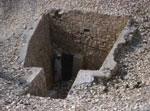





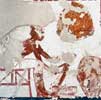




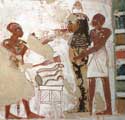


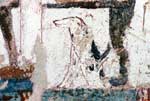
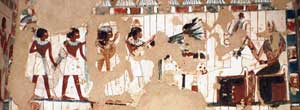
No comments:
Post a Comment